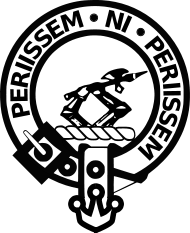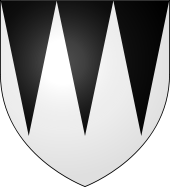- Clan Anstruther
-
Clan Anstruther Crest badge 
Crest: Two arms in armour holding a pole-axe with both hands gauntleted Proper Motto: Periissem ni periissem Profile Region Lowlands District Fife Chief

Tobias Alexander Anstruther of that Ilk [1] Chief of the Name and Arms of Anstruther Seat Balcaskie House.[2] Clan Anstruther is a Scottish clan from Anstruther in Fife, in the east of Scotland.
Contents
History
Origin of name
From the town of Anstruther, which was adopted as a familial name.
Origins of the Clan
Alexander I of Scotland granted the lands of Anstruther to William de Candela in the early 12th century. There are a number of suggested origins for William but research points to the Normans in Italy. It is known that William I of England sought assistance from William, Count of Candela, who sent his son. It is likely that this son was William de Candela, who received the grant of land from Alexander.
William de Candela's son, also William, was a benefactor to the monks of Balmerino Abbey. The site now occupied by the Scottish Fisheries Museum in Anstruther was a gift from William. The next generation of the family, Henry, no longer styled himself , de Candela, being described as 'Henricus de Aynstrother dominus ejusdem' in a charter confirming grants of land to Balmerino Abbey.
Henry Anstruther accompanied Lois IX to the crusades and swore fealty to King Edward I of England in 1292 and again in 1296.
16th Century & Anglo-Scottish Wars
In 1483, Andrew Anstruther of Anstruther confirmed the right to a barony and fought against the English at the Battle of Flodden Field in 1513 during the Anglo-Scottish Wars.[citation needed]
His second son, David, fought at the Battle of Pavia in 1520 in the service of Francis I of France in the French Scots Regiment. This line ended with the death of the last Baron d'Anstrude in 1928.[citation needed]
Andrew's great-great-grandson,[citation needed] Sir James Anstruther was chosen as a companion to the young James VI of Scotland, who appointed him Hereditary Grand Carver,[3] a title still held by the head of the family today.[citation needed] In 1595 he became Master of the Household.[3]
17th Century & Civil War
William, the elder son of Sir James Anstruther, accompanied Sir James to London following the Union of the Crowns in 1603 where he was made a Knight of the Order of the Bath. Sir James's second son, Sir Robert, served as a diplomat for both James I and Charles I. [4]
Sir Phillip Anstruther, the second son of Sir Robert, led the Clan and fought as Royalists during the civil war, and received Charles II at Dreel Castle after his coronation at Scone in 1651. Phillip Anstruther was later taken prisoner after the Battle of Worcester in 1651.[4] He was excluded from Cromwell's Act of Grace and his estates were confiscated. They were restored to him after the restoration of the monarchy by Charles II.[5]
Clan Chief
The Chief of Clan Anstruther is Tobias Alexander Campbell Anstruther of that Ilk and of Balcaskie.[6]
Clan Castles
The Chief's seat remains at Balcaskie. Airdrie House and Newark Castle in Fife also belong to the Anstruthers.
Clan Profile
- Crest: Two arms in armour holding a pole-axe with both hands gauntleted Proper
- Motto: Periissem ni periissem (I would have perished had I not persisted)
See also
External links
References
- ^ http://www.clanchiefs.org/p/chiefs.html
- ^ myclan.com
- ^ a b Burke, John Bernard (1852). A genealogical and heraldic dictionary of the peerage and baronetage of the British (14 ed.). Colburn. p. 27.
- ^ a b Burke, John Bernard (1852). A genealogical and heraldic dictionary of the peerage and baronetage of the British (14 ed.). Colburn. p. 28.
- ^
 Rigg, James McMullen (1885). "Anstruther, William". In Leslie Stephen. Dictionary of National Biography. 2. London: Smith, Elder & Co.
Rigg, James McMullen (1885). "Anstruther, William". In Leslie Stephen. Dictionary of National Biography. 2. London: Smith, Elder & Co. - ^ http://www.clanchiefs.org/p/chiefs.html
Scottish clans Clans with chiefs Agnew · Anstruther · Arbuthnott · Arthur · Bannerman · Barclay · Borthwick · Boyd · Boyle · Brodie · Broun · Bruce · Buchan · Burnett · Cameron · Campbell · Carmichael · Carnegie · Cathcart · Charteris · Chattan · Chisholm · Cochrane · Colquhoun · Colville · Cranstoun · Crichton · Cumming · Darroch · Davidson · Dewar · Drummond · Dunbar · Dundas · Durie · Elliot · Elphinstone · Erskine · Farquharson · Fergusson · Forbes · Forsyth · Fraser · Fraser of Lovat · Gayre · Gordon · Graham · Grant · Gregor · Grierson · Guthrie · Haig · Haldane · Hamilton · Hannay · Hay · Henderson · Home · Hope · Hunter · Irvine · Jardine · Johnstone · Keith · Kennedy · Kerr · Kincaid · Lamont · Leask · Lennox · Leslie · Lindsay · Lockhart · Lumsden · Lyon · MacAlister · MacBain · MacDonald · Macdonald of Clanranald · MacDonald of Keppoch · Macdonald of Sleat · MacDonell of Glengarry · MacDougall · Macdowall · MacIntyre · Mackay · Mackenzie · Mackinnon · Mackintosh · Maclachlan · Maclaine of Lochbuie · MacLaren · MacLea (Livingstone) · Maclean · MacLennan · MacLeod · MacLeod of Lewis · MacMillan · Macnab · Macnaghten · MacNeacail · MacNeil · Macpherson · MacTavish · MacThomas · Maitland · Makgill · Malcolm (MacCallum) · Mar · Marjoribanks · Matheson · Menzies · Moffat · Moncreiffe · Montgomery · Morrison · Munro · Murray · Napier · Nesbitt · Nicolson · Ogilvy · Oliphant · Primrose · Ramsay · Rattray · Riddell · Robertson · Rollo · Rose · Ross · Ruthven · Sandilands · Scott · Scrymgeour · Sempill · Shaw · Sinclair · Skene · Spens · Stirling · Strange · Stuart of Bute · Sutherland · Swinton · Trotter · Urquhart · Wallace · Wedderburn · Wemyss · Wood ·
Armigerous clans Abercromby · Abernethy · Adair · Adam · Aikenhead · Ainslie · Aiton · Allardice · Anderson · Armstrong · Arnott · Auchinleck · Baillie · Baird · Balfour · Bannatyne · Baxter · Bell · Belshes · Bethune · Beveridge · Binning · Bissett · Blackadder · Blackstock · Blair · Blane · Blyth · Boswell · Brisbane · Buchanan · Butter · Byres · Cairns · Calder · Caldwell · Callender · Campbell of Breadalbane · Campbell of Cawdor · Carruthers · Cheyne · Chalmers · Clelland · Clephane · Cockburn · Congilton · Craig · Crawford · Crosbie · Cunningham · Dalmahoy · Dalrymple · Dalzell · Dennistoun · Don · Douglas · Duncan · Dunlop · Edmonstone · Fairlie · Falconer · Fenton · Fleming · Fletcher · Forrester · Fotheringham · Fullarton · Galbraith · Galloway · Gardyne · Gartshore · Ged · Gibsone · Gladstains · Glas · Glen · Glendinning · Gray · Gunn · Haliburton · Halkerston · Halket · Hepburn · Heron · Herries · Hogg · Hopkirk · Horsburgh · Houston · Hutton · Inglis · Innes · Kelly · Kinloch · Kinnaird · Kinnear · Kinninmont · Kirkcaldy · Kirkpatrick · Laing · Lammie · Langlands · Learmonth · Little · Logan · Logie · Lundin · Lyle · MacAulay · Macbrayne · MacDuff · MacEwen · MacFarlane · Macfie · Macgillivray · MacInnes · MacIver · Mackie · MacLellan · Macquarrie · Macqueen · Macrae · Masterton · Maule · Maxton · Maxwell · McCorquodale · McCulloch · McKerrell · Meldrum · Melville · Mercer · Middleton · Moncur · Monteith · Monypenny · Mouat · Moubray · Mow · Muir · Murray of Atholl · Nairn · Nevoy · Newlands · Newton · Norvel · Ochterlony · Orrock · Paisley · Paterson · Pennycook · Pentland · Peter · Pitblado · Pitcairn · Pollock · Polwarth · Porterfield · Preston · Pringle · Purves · Rait · Ralston · Renton · Roberton · Rossie · Russell · Rutherford · Schaw · Seton · Skirving · Somerville · Spalding · Spottiswood · Stewart · Stewart of Appin · Strachan · Straiton · Strange · Sydserf · Symmers · Tailyour · Tait · Tennant · Troup · Turnbull · Tweedie · Udny · Vans · Walkinshaw · Wardlaw · Watson · Wauchope · Weir · Whitefoord · Whitelaw · Wishart · Young
Culture and society Scotland · Clan chief · Septs · Clan badge · Clan crest · Clan battles · Tartan · Bagpipes · Clearances · Kilt · Manrent · The Highlands · Battle of Culloden · Highland games · Border Reivers · Scottish heraldry · Scottish surnames
Categories:- Scottish clans
Wikimedia Foundation. 2010.
